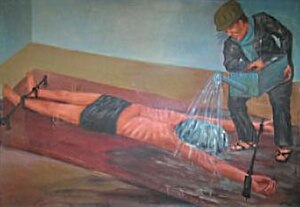1975: After taking power, the Khmer Rouge leadership renamed the country “Democratic Kampuchea“. The Khmer Rouge subjected Cambodia to a radical social reform process that was aimed at creating a purely agrarian-based Communist society. The city-dwellers were deported to the countryside, where they were combined with the local population and subjected to forced labor. About 1.5 million Cambodians died in waves of murder, torture, and starvation, aimed particularly at the educated and intellectual elite.
Losing power following a Vietnamese military intervention in December 1978, the Khmer Rouge maintained control in some regions and continued to fight on as guerrillas. In 1998, their final stronghold in Anlong Veng District, fell to the government.
Following their leader Pol Pot, the Khmer Rouge imposed an extreme form of social engineering on Cambodian society. A radical form of agrarian communism where the whole population had to work in collective farms or forced labor projects. In terms of the number of people killed as a proportion of the population (est. 1.75 million people, as of 1975), it was one of the most lethal regimes of the 20th century.
The Khmer Rouge wanted to eliminate anyone suspected of “involvement in free-market activities”. Suspected capitalists encompassed professionals and almost everyone with an education, many urban dwellers, and people with connections to foreign governments.
The Khmer Rouge believed parents were tainted with capitalism. Consequently, children were separated from parents and brainwashed to socialism. And then were taught torture methods with animals. Children were a “dictatorial instrument of the party” and were given leadership in torture and executions.
Tuol Sleng Genocide Museum

Yesterday, we visited the Killing fields of Choeung Ek, where prisoners were taken in trucks to be killed. And today, we went to the Tuol Sleng Genocide Museum in Phnom Penh. There is no exact count of how many people were murdered in the Genocide of Pol Pot’s Regime in the 1970s. But figures estimate as high as 3 million victims. Tuol Sleng Center was known as “security center 21 (s21)”, which was a former high school. During the years of the genocide, the government used it as an “interrogation center” where they took random people accused as “threats” to society. Many were intellectuals and those opposed to the government. Pol Pot’s regime framed them as people who would threaten and “pollute” the mind of the public and challenge the government:
“In the early months of S-21’s existence, most of the victims were from the previous Lon Nol regime. They included soldiers, government officials. As well as academics, doctors, teachers, students, factory workers, monks, engineers, etc. Later, the party leadership’s paranoia turned on its own ranks and purges throughout the country saw thousands of party activists and their families brought to Tuol Sleng and murdered.”
Short Films and Photography Available for Viewing of the Cambodian Genocide
At the Tuol Sleng Museum, we watched a film narrated by a an elder lady who survived the genocide. Her daughter and lover were separated from her and murdered. She read correspondent love letters she still held on to. Cambodia until this day, and forever, will suffer from the brutality that existed just 40 years ago to it’s own people.
Each class room at the Tuol Sleng Museum has been preserved to show visitors what happened in those atrocious years. One classroom shows photos and stories of victims. Another room displays photography of soldiers who served during that time. They were involved in torturing innocent lives. But claimed to have been forced or brainwashed to do it then. In another building, there were individual mug shots of men, women and children that were killed. Other classrooms where actual small prison cells were remains today. There, victims were detained in spaces barely larger than their own bodies. And beds where they were chained down to. Barbed wires outline the school so victims could not commit suicide.
History Lesson of Pol Pot’s Regime for Visitors
The photographs were shocking and nauseating because they were real events that actually happened. It became more real because they are not some historical texts we read about in a history book. The stories had faces attached to it. Millions of innocent children, heads cut off of women, all raw for you to see.

There were even photos of them being tortured, chained to bars, head drowned in tubs and beheaded. Tons of bodies lined next to each other tortured. There were reported 12 people that survived this genocide. There was a museum filled with skulls and clothing found. The same at the Cambodian killing fields, tons of skulls on display. Families who found the center later on couldn’t even identify their own family because the bodies had been so horrifically disseminated.
As light breezes swifted in during my vist at the school, I couldn’t help but feel the ghosts of these victims. Not giving up hope. Wanting their stories to be told. Begging the Cambodian people and the universe to learn from the lessons of this nasty era. Ghosts and Spirits still screaming, consistently since 1975. In hopes someone will hear them. And that someone could take them to see their family, just: One. Last. Time.
Read more on Tuol Sleng Museum: http://www.killingfieldsmuseum.com/s21-victims.html
